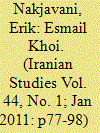| Srl | Item |
| 1 |
ID:
101288


|
|
|
|
|
| Publication |
2011.
|
| Summary/Abstract |
This paper is an in-depth study of The Confessions of Dolgoruki, the purported memoirs of a nineteenth-century Russian ambassador to Iran, long adduced as a document proving the claim that the Bahamacr'i-s of Iran are spies of foreign powers. It unearths several early versions of the text, contextualizes the creation of The Confessions, exams the zeitgeist that produced it, and tracks the changes the text went through as the dominant socio-political discourse changed over time. In discussing the range of reactions The Confessions provoked, this paper traces the intriguing path through which this text created the masternarrative of Bahamacr'i- espionage. Finally, a hypothesis regarding the identity of the original creator of the text is advanced.
|
|
|
|
|
|
|
|
|
|
|
|
|
|
|
|
| 2 |
ID:
101290


|
|
|
|
|
| Publication |
2011.
|
| Summary/Abstract |
This article focuses on how Esmail Hkoi poetically inhabits the world of his poetry as an observer and visionary explorer. Its aim is to make manifest how he engages his readers in reciprocal poetic dialogues to communicate his unique vision of the lived world. The dialogic function of his poetry is then examined as the ground of emergence of an experiential poetic mode of knowledge of the human condition. The article also considers Khoi's poetry as work done in the fields of language, alchemically transmuting everyday language of communication into poetic discourse. Finally, an analysis of his poem "To the Aged Mulberry Branch" explicates how Khoi can create a world of imagination whole and entire unto itself by his minimalist approach to poetry.
|
|
|
|
|
|
|
|
|
|
|
|
|
|
|
|
| 3 |
ID:
101289


|
|
|
|
|
| Publication |
2010.
|
| Summary/Abstract |
The two decades, 1925-45, witnessed a dramatic transformation and revitalization of the Persian carpet industry in response to developments in Iranian governance, society and economy. Two historical watersheds were covered by that period, notably the replacement of the Qajar dynasty by a modernizing administration under Reza Shah Pahlavi, and the subsequent wartime occupation of Iran jointly by the Soviet Union and Great Britain. It was during those two decades that Iran acquired a centralized system of government and the beginnings of a modern industrial base. The accompanying social transformation brought about the emergence of new classes of administrators and managers who constituted the dominant elite of the Reza Shah era. This twin process of centralization and modernization had a telling impact on Iranian culture and the arts, including the carpet arts.
|
|
|
|
|
|
|
|
|
|
|
|
|
|
|
|
| 4 |
ID:
101291


|
|
|
|
|
| Publication |
2011.
|
| Summary/Abstract |
As a key primary source for the history of the eleventh-century Isma'ili majlis, the Fatimid chief missionary al-Mu'ayyad fi al-Din al-Shirazi's autobiographical Sira offers a prime opportunity to consider the application of centralizing features of the Fatimid state in eleventh-century Buyid Shiraz. Previous studies on the Fatimid majlis have raised questions about an Isma'ili core curriculum as well as the intended audience/s of Fatimid da'wa teachings. This article situates al-Mu'ayyad's memoir in the broader context of the Persian and Arabic historiographical traditions in order to provide new insights into the transmission of Isma'ili doctrines in different social settings outside of Fatimid Cairo. It concludes that Abu Kalijar's study sessions with al-Mu'ayyad suggest that Qadi al-Nu'man's Kitab Da'a'im al-Islam was used as a core text for introducing some of the main principles of Fatimid religio-political rule in addition to Isma'ili doctrines to non-Isma'ili audiences.
|
|
|
|
|
|
|
|
|
|
|
|
|
|
|
|
| 5 |
ID:
101287


|
|
|
|
|
| Publication |
2010.
|
| Summary/Abstract |
More than a generation has passed since the substantial immigration of Iranians to the United States in the late 1970s, resulting in a sizable second-generation population (defined by convention as persons born in the United States and those who immigrated under the age of thirteen). This article presents a first look at the demographic and socioeconomic characteristics of the second generation at the national level, and compares them with those of the first generation (Iran- or foreign-born population). It uses the 2005-07 merged data set compiled by the United States Census in the American Community Survey (ACS). The results indicate a preliminary continuation of economic and educational success from the first- to the second-generation Iranians. Moreover, this achievement has become more balanced across gender lines in the second generation. Specifically, in terms of educational attainment and labor force participation, females have quickly closed the gap with their male counterparts. Because the second generation is still young, it is premature to assess the extent of intergenerational mobility among Iranians. But given this generation's initial achievements, one can only expect an upward trajectory.
|
|
|
|
|
|
|
|
|
|
|
|
|
|
|
|